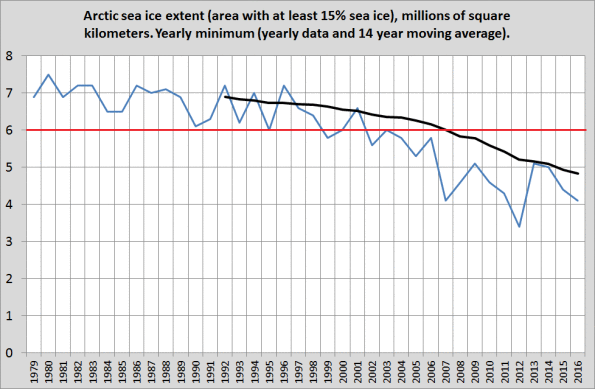At this very moment (9 september 2016), arctic sea ice may have reached its yearly minimum extent. Does global warming cause a decline of this minimum? Business cycle economists use the phrase ‘months for cyclical dominance’: how many months does it take before trend movements are larger than monthly fluctuations of variables like consumption of exports? In the case of sea ice I used ‘years for cyclical dominance (YCD)’: a fourteen year moving average shows a continuous decline (the max. extent of arctic sea ice has a 10 year YCD). The decline is not linear. Remarkably, pre-2002 minima of the minimum are higher than post-2006 maxima of the minimum – a very robust indicator of a downward trend. Antarctic sea ice shows much less dramatic developments. This reminds us that we have to look at the global picture. Which is clear: 2016 is set to be the hottest year on record (breaking the 2015 record).
Topics:
Merijn T. Knibbe considers the following as important: Uncategorized
This could be interesting, too:
tom writes The Ukraine war and Europe’s deepening march of folly
Stavros Mavroudeas writes CfP of Marxist Macroeconomic Modelling workgroup – 18th WAPE Forum, Istanbul August 6-8, 2025
Lars Pålsson Syll writes The pretence-of-knowledge syndrome
Dean Baker writes Crypto and Donald Trump’s strategic baseball card reserve
 At this very moment (9 september 2016), arctic sea ice may have reached its yearly minimum extent. Does global warming cause a decline of this minimum? Business cycle economists use the phrase ‘months for cyclical dominance’: how many months does it take before trend movements are larger than monthly fluctuations of variables like consumption of exports? In the case of sea ice I used ‘years for cyclical dominance (YCD)’: a fourteen year moving average shows a continuous decline (the max. extent of arctic sea ice has a 10 year YCD). The decline is not linear. Remarkably, pre-2002 minima of the minimum are higher than post-2006 maxima of the minimum – a very robust indicator of a downward trend. Antarctic sea ice shows much less dramatic developments. This reminds us that we have to look at the global picture. Which is clear: 2016 is set to be the hottest year on record (breaking the 2015 record).
At this very moment (9 september 2016), arctic sea ice may have reached its yearly minimum extent. Does global warming cause a decline of this minimum? Business cycle economists use the phrase ‘months for cyclical dominance’: how many months does it take before trend movements are larger than monthly fluctuations of variables like consumption of exports? In the case of sea ice I used ‘years for cyclical dominance (YCD)’: a fourteen year moving average shows a continuous decline (the max. extent of arctic sea ice has a 10 year YCD). The decline is not linear. Remarkably, pre-2002 minima of the minimum are higher than post-2006 maxima of the minimum – a very robust indicator of a downward trend. Antarctic sea ice shows much less dramatic developments. This reminds us that we have to look at the global picture. Which is clear: 2016 is set to be the hottest year on record (breaking the 2015 record).
